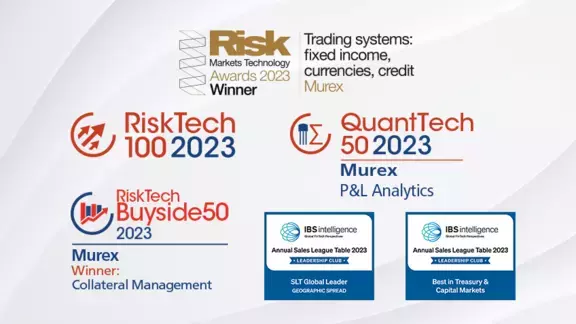-
Our solutions
- Our clients

With 300 clients and 60,000 users spread across 60 countries around the world, Murex has a truly international client base of capital markets participants.
view all case studies- Insights
- Who we are

Our awards highlight a strong level of customer satisfaction and acknowledge our market expertise.
Visit our awards webpage- Our partners
- Careers
Shifting Regulations, Enhanced Digitalization, Consolidation in Financial Tech and Financial Sector Might Accelerate in 2021
by Stella Clarke, Chief Marketing Officer
The unforeseeable disruptions of last year were humbling (remember that oil went negative) and unpredictability in the markets generally and the financial sector more broadly is set to remain a powerful factor this year. I will, therefore, be cagey on making predictions. There are, however, core, nonprivate issues I can address—themes, we’ll call them—as Murex considers the year. I wanted to share a few of those.
The dynamic regulatory agenda will keep Murex and its client community busy.
Where to start? To keep it light, let’s focus on the IBOR reform.
The risk of a lengthy IBOR transition featuring multiple phases and disparity across currencies, asset classes and tenors remains. ISDA protocol adoption has been positive, but questions persist regarding cash products and cleared derivatives transitions. Core technology must be able to support diverse transition regimes and accommodate a flexible, ever-evolving calendar.
The regulatory agenda will keep everyone in our space locked onto the latest news and developments with the ISDA IBOR fallback. As Murex Head of Rates, Bonds and Credits Didier Loiseau writes in a recent blog post, the bulk of USD 400 trillion in financial derivatives contracts will likely be transitioned from LIBOR in two phases. The first phase will come at the end of 2021.
This is a massive, global story, with a huge impact on the financial sector. Our clients, meanwhile, will need to be using the right IBOR solution technology to manage two aspects of the transition: practitioners must adapt their strategy to a timeline that remains fluid; and participants must account for the transition in calculations and models pegged to announcement dates. Again, read Didier’s piece—it gives a sense of just one (exceedingly complex) thing Murex experts are thinking about.
There is clearly an acceleration of digital transformation.
This digital transformation point likely does not come as a surprise to anyone watching the financial technology and financial sector space—digital transformation is being undergone throughout our community nearly everywhere.
When the pandemic struck, its effects on our clients were incremental. They were first preoccupied with business continuity, which was essential in the early days of lockdowns. Another consequence of the effects of the pandemic should be our clients’ needs to better serve their clients through digital channels. Previously, for example, a sales executive visiting a client would be able to experience their trading floor and observe client positions. Under current conditions, information must be accessed digitally, with product pricing and distribution conversations taking place virtually.
Pandemic conditions accelerated the trend of business process digitization behind capital markets, treasury and investment management.
We expect a significant budget shift at financial institutions toward process digitization and data access. There are two main reasons for this: financial institutions must undergo internal transformation to enable their workforce by robustly supporting remote work; and end-user interaction will also see significant, needed change. Front-end transformations are no longer sufficient—to truly unlock digitization possibilities, transformation of core and back-office IT is required. While the digitization in retail and wealth business is well advanced, wholesale and capital markets are likely to catch up in 2021. We expect this to be at the top of IT and business leader agendas.
Agility, cloud and Platform as a Service, and TCO reduction have increased relevance.
Ten years ago, Murex (among many others who have weathered the storm of the global pandemic) would not have been as prepared for the realities of remote working. As a result of years of preparation not directly related to the current context, our organization strikes the right balance between in-person and remote working as the pandemic heightens, abates, shifts and morphs. Murex contributed to an AFME white paper, “Adopting Agile Work Practices at Scale in European Capital Markets,” which has heightened relevance in this context. Before the pandemic, even, advances in the cloud, which are powering our business in so many ways, have changed the ways we collaborate.
Many financial technology customers are actively weighing the benefits of having software managed by the software developer to bring dev and ops together. This year, we expect an increase in the number of clients that prefer SaaS on self-managed deployment. In parallel, Murex continues to deliver a packaged regulatory solution for risk and capital management that includes the latest global and local regulatory changes. We are committed to continually improve the total cost of operation and evolution for our clients. As we continue to invest in infrastructure, configuration and test as a code, we expect more and more clients to transform their operations and how they manage the MX.3 platform in 2021.
We see 2021 as a year of cloud adoption in capital markets, with many workloads being transferred to the public cloud. We expect to see a 100-percent increase this year as more and more hybrid deployment possibilities are enabled.
Murex sees consolidation in the financial services space.
Here, I should note some important consolidation trends our space is experiencing. S&P Global announced its acquisition of IHS Markit for USD 44 billion last year in a major play for information in our space and a major validation and affirmation of the importance of data going forward.
We are not going to comment on specifics, but this is only one of the biggest examples of the increased consolidation the financial technology and financial services spaces are experiencing.
On the sell-side, we’re seeing clear trends of consolidation to maximize return on equity and to fight against declining margins. In asset management, scale clearly matters, and there is a desire to increase partnership across technology providers and asset servicers to supply end-to-end services to small and mid-tier actors.
In this context, there is an increased need to differentiate your offerings to stand out in an incredibly competitive field.
With MX.3 in a state of constant evolution, Murex sees itself as well positioned to meet the ever-changing needs of a wide, diverse community of sell-side and buy-side clients. It is clear technology will continue to transform financial services and we are looking to be at the heart of this transformation. This is a complex journey with quick evolution. Rapid action and adaptation are imperative to maintain a competitive edge.
You might be interested in ...
- Our clients


